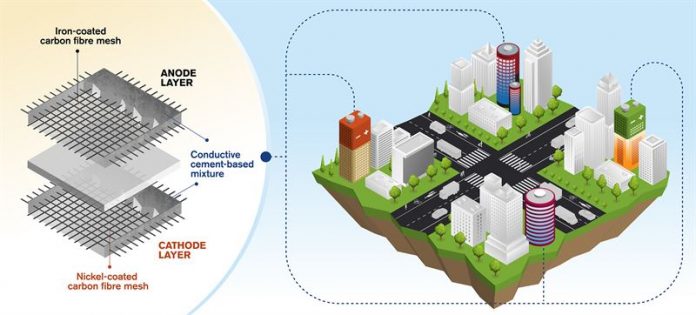Research from Chalmers University of Technology, Sweden have outlined a new concept for rechargeable cement-based batteries
Doctor Emma Zhang, formerly of Chalmers University of Technology, Sweden, joined Professor Luping Tang’s research group to search for the building materials of the future.
Together they have now succeeded in developing a world-first concept for a rechargeable cement-based battery.
The concept involves a cement-based mixture, with small amounts of short carbon fibres added to increase the conductivity and flexural toughness. Then, embedded within the mixture is a metal-coated carbon fibre mesh – iron for the anode, and nickel for the cathode.
‘Thinking out of the box’
“Results from earlier studies investigating concrete battery technology showed very low performance, so we realised we had to think out of the box, to come up with another way to produce the electrode.
“This particular idea that we have developed – which is also rechargeable – has never been explored before. Now we have proof of concept at lab scale,” said Emma Zhang.
Luping Tang and Emma Zhang’s research has produced a rechargeable cement-based battery with an average energy density of 7 Watthours per square metre. Energy density is used to express the capacity of the battery, and a modest estimate is that the performance of the new Chalmers battery could be more than ten times that of earlier attempts at concrete batteries. The energy density is still low in comparison to commercial batteries, but this limitation could be overcome thanks to the huge volume at which the battery could be constructed when used in buildings.
Emma Zhang said: “It could also be coupled with solar cell panels for example, to provide electricity and become the energy source for monitoring systems in highways or bridges, where sensors operated by a concrete battery could detect cracking or corrosion.
“We have a vision that in the future this technology could allow for whole sections of multi-storey buildings made of functional concrete.
“Considering that any concrete surface could have a layer of this electrode embedded, we are talking about enormous volumes of functional concrete.”
“We are convinced this concept makes for a great contribution to allowing future building materials to have additional functions such as renewable energy sources,” added Luping Tang.














